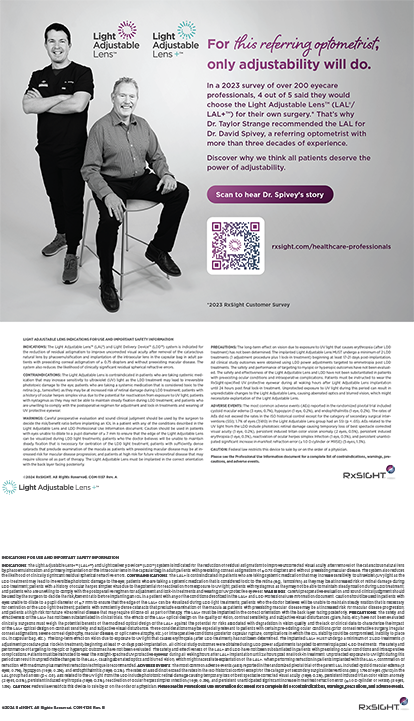
There is a saying in digital marketing: When you try to reach everyone, you impact no one. Why does this matter to a busy ophthalmologist? Because this rule offers the key to acquiring new patients through social media and other digital platforms.
Even if you already promote yourself and your practice on Facebook and Instagram and interact with other ophthalmologists on Twitter, you may not be reaching potential patients in today’s fast-paced social media world. In this article, I will walk you through specific steps to help you influence the patients you want using social media.
BILLBOARD VersuS HYPER-TARGETED
When social media platforms first gained popularity, marketers applied traditional advertising tactics to reach their respective audiences. Traditional advertising relies on maximum reach and frequency—an approach that creates the desired high-quality impressions, but it also produces quite a bit of waste.
For example, an advertiser buys a billboard on a highway, guaranteeing maximum reach and frequency among thousands of local commuters repeating the same daily route. But it’s easy to imagine that 80% of the people who drive past the billboard are not part of the advertiser’s target audience—and that many others who are in that target audience take a different route to work.
A traditional spray-and-pray approach like this does not apply to social media, which works by targeting sequences of ads to individuals based on their interests, actions, and behaviors. Hyper-targeted social media campaigns are exponentially more efficient and effective when the marketer has an intimate understanding of the target audience or audiences (see Steps to Hyper-Targeting Your Audience). Instead of maximum reach and frequency, one can specifically target audiences most likely to purchase a product or service. Unlike the billboard on the highway, with social media you reach only the people you want with multiple messages based on data and insights. This results in virtually no wasted impressions.
STEPS TO HYPER-TARGETING YOUR AUDIENCE
Break down your audience by location, demographics, interests, diagnoses, and the services they receive from you
Determine your target audience
Think about your conversations with the target audience and outline common characteristics
Craft a message just for them
Allocate a budget and test each platform to determine the best medium for your product
Test a mix of images and graphics on your primary social media outlet; determine the one with the highest number of clicks, best click-through rate, and greatest relevance score
Take that same image and text and promote it on your secondary social media outlets
Compare results and select the winning outlet and message
By hyper-targeting your audience by location, demographics, and interests, you can tailor your message to subsegments of your target audience. For example, if your aim is to reach new patients interested in refractive surgery, you can create an ad to target university-age students living in your area who play sports or show an interest in beauty topics.
KNOWING YOUR AUDIENCE
Your audience isn’t everyone. Do you know who it is?
To determine your target audience, first look at a breakdown of your current patient demographics, their diagnoses, and the services they receive from you. For the purposes of this example, let’s say your patient base is evenly split like this:
- 25% general ophthalmology (median age 40 years);
- 25% refractive surgery (median age 30 years);
- 25% cataract surgery (median age 75 years); and
- 25% other surgeries, such as corneal transplantation (median age 55 years).
Which one of these groups do you want to expand? Are you offering a new treatment, such as refractive cataract surgery with premium IOLs? Do you want to grow your reimbursed treatments or your out-of-pocket procedures? Let’s say, for the sake of this example, that you want to start offering a new procedure for dry eye disease (DED), such as thermal pulsation, for patients ages 30 to 65 years.
To target these individuals on social media, think about your conversations with your existing DED patients and outline common characteristics. Some might be as follows:
- They are in their prime years, with busy lives;
- They view DED as a hindrance to their careers, activities, and appearances;
- They log many hours of screen use;
- They have other concurrent conditions such as perimenopause, facial rosacea, or autoimmune disorders; and
- They are often contact lens dropouts.
If you need more information about your DED patients, ask your staff members who spend time with them. You can also list common characteristics of people in your community you want to target for DED services, such as students at a university or employees at a local firm.
THE RIGHT MESSAGE AND PLATFORM
Once you have a clear picture of your target audience, you are ready to craft a message just for them. For example, you might pair an image of a young professional with the text: “You’ll never make your deadline with red, scratchy eyes. To have clear, refreshed eyes for hours, visit [your clinic name].”
So how do you know which platform to start with? To choose the best social media platform for your target audience, consider the demographics of each platform’s users. The social media management software firm Sprout Social has broken down some of the market segmentation of today’s popular social media platforms on its website.1 It is a worthwhile read.
Choosing the right platform is also about testing a mix of images and graphics. Despite all the research and data in the world, you should always allocate a budget and test each platform to determine the best medium for your product. The best way to approach this is to begin with your practice’s strongest network (eg, Facebook) and test three to four images and messages. Wait 7 days, and then determine the one with the highest number of clicks, best click-through rate, and greatest relevance score.2 Then you can take that same image and text and promote it on your secondary networks (eg, Twitter or Instagram).
Social media platforms also serve different purposes:
- Facebook is best for overall brand awareness;
- Instagram is designed for users to share and engage through images and video;
- Twitter is most useful for sharing industry news and presenting yourself as a thought leader; and
- LinkedIn, aimed at professionals, works well for highlighting positive product and clinical trial news.
To target your DED audience, you might create a compelling video or animation that evokes an emotional response from patients. You want them to think, “Hey, I feel that way,” or “Ugh, I know that feeling,” or “Yes I need to try something new.”
CRAFTING COPY
When you craft copy, you want to consider how you want the audience to feel. Remember, it is less about you and more about them. Once you finalize the copy, you can reach your desired patients through strategic targeting. Each network has its own features for targeting. On Twitter, you can target followers of DED support groups, DED products, and key hashtags related to DED (eg, #dryeye). You can also add location and age restrictions to your ads.
On Facebook, you target by interests. You can start by targeting those with demonstrated interests in DED or related problems, such as rosacea or Sjögren syndrome. Further, Facebook has a category called Health & Wellness Buyers, which may be a good segment to add.
But remember, you have to test because you are always measuring your cost against your results. (For tips on where to start or how to update old content, see Optimizing Free Social Media Efforts.)
OPTIMIZING FREE SOCIAL MEDIA EFFORTS
If your social media presence is incomplete or out of date, you should update it before using it to target new patients. This means updating banners to be consistent across all your networks and having the same profile photo on all networks.
If you aren’t sure about what to post, start with these examples:
- With patient consent, post before and after photos of treatments or patients: for example, before and after DED treatments or patients getting rid of their glasses after LASIK, on Instagram and/or Facebook;
- On Twitter or Instagram, post pictures of company events and show employee personality;
- On Facebook, post reminders for routine exams and other services you offer;
- Update your LinkedIn profile so that potential patients can learn details about your professional history;
- Use LinkedIn and Facebook to share practice news, such as receiving a community or industry award; and
- Share research and technology news with others in your profession on Twitter.
On Twitter, hashtags are an easy way to reach your audience. You can develop a hashtag to use in all of your tweets. (Hashtag Helper is a great resource for this.1) For example, if you practice in Plymouth, England, and focus on refractive surgery, you could use the hashtag #PlymouthLASIK. Before you use your hashtag, search for it on Twitter to make sure it is not already being used.
On Facebook, you have the option to pin an important post on your wall, which will keep it at the top of your wall for up to 7 days, even if you add more posts. Facebook users will see the pinned post before other content on your wall.
1. Showing relevance scores for ads on Facebook. https://www.facebook.com/business/news/relevance-score. Accessed August 7, 2018.
REVIEWS, INTERACTION, AND MONITORING
Interaction has a role in all aspects of digital marketing. On social media platforms, followers can reply or comment on your posts or create their own posts that mention you. For example, you can read comments on your Facebook page as well as search Facebook for mentions of you or your practice name. You can check your mentions in the Twitter activity tab, and you can search for your name or hashtag (once you’ve created one). When people use your hashtag, they help boost your brand, spread the word about your practice, and drive in new patients.
To reach out to potential patients on Facebook, you can get involved in health care community forums. There are plenty of private Facebook groups focused on specific health conditions, such as ocular surface disease, corneal transplantation, Sjögren syndrome, keratoconus, and many others. You can request to join these groups and get involved in the conversation. After being accepted, make sure to read the group’s guidelines, which might prohibit promotional posts. Most important, be your authentic self when interacting in social media communities.
One important type of digital marketing interaction is the review. Reviews are a crucial part of a successful social media and web presence. Facebook allows users to leave reviews of businesses, and many reviews are posted on Google and Yelp. Whether reviews of your practice are positive or negative, it is important to respond to all of them. This is an opportunity to engage with a happy customer or reconcile a patient’s less-than-perfect experience. (Yelp does not allow responses to positive reviews but encourages reconciliation of negative reviews.)
Responding to reviews can be a time-consuming task. I suggest creating a response protocol to make the process as easy as possible. List potential reviews and how you want to respond to them. Common positive reviews might include how you helped someone look or feel better or really listened, whereas common negative reviews often involve long wait times, issues with billing, or dissatisfaction with treatment. Add to the list as you receive new reviews.
For example, let’s say that Jane Doe writes a review that says: “Dr. Smith is a great ophthalmologist. She is very personable and takes the time to talk with me during each of my appointments. Thanks to her, my eyes feel so much more comfortable!” You can respond to this and other positive reviews by writing: “Thank you for your kind words!” Conversely, her sister June Doe might write: “At Dr. Smith’s office today, the front desk staff acted like they couldn’t care less about helping me schedule my next appointment.” A generic response might be: “Hi, June. Thank you for reaching out. We are sorry to hear you had a less than ideal experience. Please send us the best way to contact you via private message and we will be in touch soon!”
For Google reviews, I recommend that you include in your response a request to take a short demographic survey, which you can create on a site like SurveyMonkey. This will enable you to capture reviewers’ email addresses, which you can use to conduct email marketing and create custom audiences to target on Facebook. (Disclaimer: Make sure to follow any applicable laws on digital advertising consent in your country when creating custom audiences for social ads.) Once you receive patient consent, you can create custom audiences on Facebook with Facebook Ads Manager. You will have the option to remarket your ads to a custom audience made up of individuals from your email list.
Yelp Knowledge and Google My Business listings offer great free ways to help improve search engine optimization while appealing to your patients. These listing platforms offer detailed analytical tools that directly illustrate your listing’s return on investment. On Google My Business, you can monitor the number of search results your listing appeared in; the number of listing views; your reviews; and valuable customer actions, such as the number of consumers who visited your website, requested directions, or called.
Yelp Knowledge analytics offers the same types of details, but the platform allows you to assign a value to each customer action, which in marketing is known as a conversion. For example, you can assign a higher value to a customer who calls your practice than to someone who looks at your website. This allows you to see the estimated return on investment for your Yelp conversions without doing the math yourself.
PAID DIGITAL MARKETING
When I take on a new digital marketing client, I often hear: “I took the time to build out my social media pages and I post engaging content frequently, but I am not seeing the results I want.” I always ask if the client is sponsoring the content. The answer is often no.
Sponsoring posts on social media is the act of putting advertising dollars behind high-performing content. First things first: Do not feel intimidated about creating sponsored social media posts, also known as paid media. The easiest way to sponsor a post on Facebook is using a process called boosting. (For a short video to walk you through boosting, visit https://vimeo.com/241195793.) In the Facebook boosting process, you can select a demographic you want to target and choose how long you want your boosted post to run. You can also define your audience by fencing around your location. For example, you can choose to reach people in Dublin and a 5-mile radius around Dublin.
You can take engagement to a higher level by creating strategically sponsored ads for Facebook and Instagram. For example, you can create an ad about premium cataract surgery and have it reach only those who have expressed interest in cataract surgery. At the same time, you can create an ad about the benefits of LASIK for athletes and target those who have demonstrated interest in LASIK. These strategically targeted ads allow you to reach multiple specific patient populations without cluttering your web page or Facebook feed. Creating strategically sponsored ads is more involved than boosting a post, but it will bring you better results.
EXPERTS CAN HELP
For a busy doctor, using digital marketing to reach new patients can be a major undertaking. Having an advocate to facilitate your digital marketing plan can help you to define your target audiences and messaging, conduct research to ensure that anyone searching current ophthalmology trends finds you, and build a brand that differentiates you from competing practices.
1. York A. Social media demographics to inform a better segmentation strategy. Sprout Social. March 6, 2017. https://sproutsocial.com/insights/new-social-media-demographics/. Accessed August 7, 2018.
2. Showing relevance scores for ads on Facebook. https://www.facebook.com/business/news/relevance-score. Accessed August 7, 2018.




